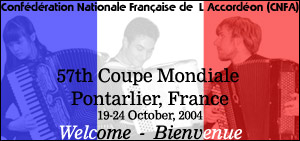|
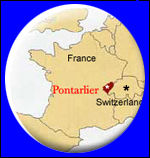 WELCOME
TO PONTARLIER! WELCOME
TO PONTARLIER!
Pontarlier
is located near the Swiss border, at the foot of Jura mountains
and is known to be the second highest town in France. Its industrial
dynamism and its numerous activities and year-round sports also
make it the "Haut Doubs" (High Doubs) region's economic
and touristic capital.
It is a convenient base into the outdoors, with access to countless
ski runs, both downhill and cross-country. 18km (11 miles) from
Pontarlier, six villages got together to create the resort called
"Métabief Mont d'Or". This resort lies at the
foot of the Mont d'Or mountain (altitude 1,463 meters) and offers
many winter and summer activities.
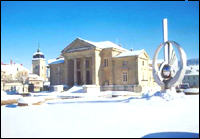 In
the 19th Century, Pontarlier was the capital of "absinthe",
an aperitif drink with a very high alcohol content, and it was
an important industry here until it was banned in 1915. The town
keeps the distillery tradition alive by producing the "Anis
of Pontarlier", a drink to which water is added. In
the 19th Century, Pontarlier was the capital of "absinthe",
an aperitif drink with a very high alcohol content, and it was
an important industry here until it was banned in 1915. The town
keeps the distillery tradition alive by producing the "Anis
of Pontarlier", a drink to which water is added.
Pontarlier (pont means in French "bridge") is located
on the river Doubs (in Latin Dubius, "dubious", because
of its complicated course) close to the border with Switzerland.
It is located at an elevation of 837 meters above sea level and
is the second highest French city after Briançon (in the
Alps). A city of some 20,000 inhabitants, the residents are known
as Pontissaliens.
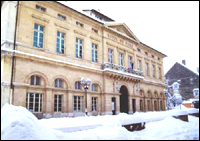 In
the XIIth century, Pontarlier was already an important city on
the ancient road linking Northern Italy to Champagne and Flanders.
In the middle of the XIIIth century, Pontarlier and eighteen neighbouring
villages constituted the Baroichage, an administrative and ecclesiastic
community ruled by the bourgeois of Pontarlier. Due to its strategic
location and its four yearly fairs, Pontarlier increased in size
and wealth until the XVIIth century. During the Ten Years' War,
Pontarlier, then a Spanish possession, was seized on 26 January
1639 after a four-day siege by the Swedish mercenaries of Bernard
of Saxe-Weimar. The city was looted and burned down. In
the XIIth century, Pontarlier was already an important city on
the ancient road linking Northern Italy to Champagne and Flanders.
In the middle of the XIIIth century, Pontarlier and eighteen neighbouring
villages constituted the Baroichage, an administrative and ecclesiastic
community ruled by the bourgeois of Pontarlier. Due to its strategic
location and its four yearly fairs, Pontarlier increased in size
and wealth until the XVIIth century. During the Ten Years' War,
Pontarlier, then a Spanish possession, was seized on 26 January
1639 after a four-day siege by the Swedish mercenaries of Bernard
of Saxe-Weimar. The city was looted and burned down.
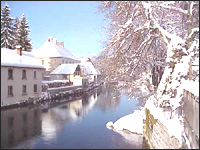 Pontarlier
was definitively incorporated to France in 1678 by the Treaty
of Nijmegen. The Porte Saint-Pierre (St. Peter's Arch) was built
at the entrance of the city to celebrate this incorporation. Its
design is similar to the Porte Saint-Martin built in Paris the
same year to celebrate the incorporation of Franche-Comté.
During the XVIIIth century, the city, mostly built with wood,
was often damaged by fire. On 31 August 1736, half of the city
was destroyed. The city was rebuilt according to the plans of
engineer Querret. In January 1871, the army commanded by General
Bourbaki was defeated by the Prussian army and ran away to Switzerland
to avoid capitulation. This was made possible by the heroic defense
of the defile of Pontarlier, upstream from the city, by General
Billot's corps. Pontarlier
was definitively incorporated to France in 1678 by the Treaty
of Nijmegen. The Porte Saint-Pierre (St. Peter's Arch) was built
at the entrance of the city to celebrate this incorporation. Its
design is similar to the Porte Saint-Martin built in Paris the
same year to celebrate the incorporation of Franche-Comté.
During the XVIIIth century, the city, mostly built with wood,
was often damaged by fire. On 31 August 1736, half of the city
was destroyed. The city was rebuilt according to the plans of
engineer Querret. In January 1871, the army commanded by General
Bourbaki was defeated by the Prussian army and ran away to Switzerland
to avoid capitulation. This was made possible by the heroic defense
of the defile of Pontarlier, upstream from the city, by General
Billot's corps.
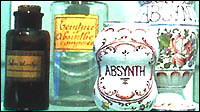 In
1797, Henri-Louis Pernod founded in Franche-Comté the first
absinthe manufacture. Two centuries later, Pontarlier was the
world capital city of absinthe. The golden age of the "green
fairy" ended in 1915 when absinth production was forbidden
because of the neurological toxicity of this alcohol. Pernod went
over into production of less dangerous aniseed beverages, including
the famous Pernod 45. In
1797, Henri-Louis Pernod founded in Franche-Comté the first
absinthe manufacture. Two centuries later, Pontarlier was the
world capital city of absinthe. The golden age of the "green
fairy" ended in 1915 when absinth production was forbidden
because of the neurological toxicity of this alcohol. Pernod went
over into production of less dangerous aniseed beverages, including
the famous Pernod 45.
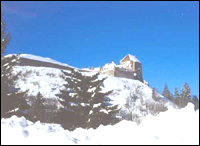 The
Fort of Joux (located 5 km (3 miles) south of Pontarlier, at an
altitude of 940 meters) was built in the XIth century to watch
the defile of Pontarlier. The
Fort of Joux (located 5 km (3 miles) south of Pontarlier, at an
altitude of 940 meters) was built in the XIth century to watch
the defile of Pontarlier.
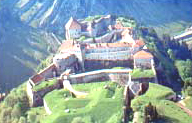 The
defenses of the fort were improved by Vauban in 1678 and by Joffre
between 1879 and 1881. The fort was mostly used as a state prison
and had a few famous guests such as Mirabeau in 1776; Toussaint-Louverture,
the hero of the Haitian independence, who died in the fort in
1803; and the German romantic writer Heinrich von Kleist believed
to be a spy and briefly jailed in 1806. The
defenses of the fort were improved by Vauban in 1678 and by Joffre
between 1879 and 1881. The fort was mostly used as a state prison
and had a few famous guests such as Mirabeau in 1776; Toussaint-Louverture,
the hero of the Haitian independence, who died in the fort in
1803; and the German romantic writer Heinrich von Kleist believed
to be a spy and briefly jailed in 1806.
The flag of Pontarlier
is horizontally divided red-white with the municipal coat of arms
placed in the middle of the flag. The municipal arms, showing
a bridge protected by a tower, reflect the strategic importance
of the city.
Pontarlier is found the following distances from these major centers:
 Paris...............
456 km Paris...............
456 km
Besançon....... 59 km
Belfort........... 120 km
Lyon.............. 199 km
Dijon............. 135 km
Neuchâtel...... 51km
Lausanne....... 60 km
Berne............ 100 km
Genève.......... 119 km
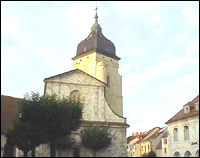 The
TGV Train is available from Paris CDG Airport to Pontarlier, or
you may take the train from Geneva or Zurich to Pontarlier. Other
convenient connections are also available. Please check your local
train schedule for further options. The
TGV Train is available from Paris CDG Airport to Pontarlier, or
you may take the train from Geneva or Zurich to Pontarlier. Other
convenient connections are also available. Please check your local
train schedule for further options.
For more information, please visit:
http://www.ville-pontarlier.fr
http://www.interfrance.com/en/fc/do_pontarlier.html
http://www.tourisme.fr/tourist-office/pontarlier.htm
Tourist Office:
Tel: (33) 03 81 46 48 33
Fax: (33) 03 81 46 83 32
E-mail: info@pontarlier.org
|
